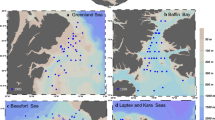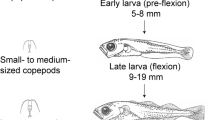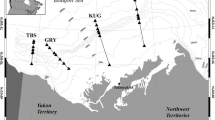Abstract
Feeding of fish depends on a spatial and temporal match with prey, and since larval and juvenile feeding can be highly selective, their preferences for given prey sizes and taxa should be considered when quantifying the actual availability of potential prey. We investigated the diet and prey preferences of the early-life stages of Atlantic cod (Gadus morhua) to quantify the availability of prey during a spring-summer season in a West Greenlandic fjord. We hypothesized that abundances of larval and juvenile cod at size were synchronized to optimal availability of preferred prey in space and time. The present analysis is based on nine cruises each covering 5 stations visited between 24 May and 5 August 2010 comparing zooplankton abundance, cod gut content and distribution patterns. Cod 4–25 mm in length preferred prey of about 5 % of their own length. During ontogeny, their preferences changed from calanoid nauplii towards Pseudocalanus spp. and Calanus spp. copepodites. The larvae/juvenile had an exceptionally high dietary contribution from cladocerans, which were highly preferred by cod larger than 9 mm, while the abundant Metridia longa and the non-calanoid copepods contributed less. These findings stress the importance of focusing on abundance of preferred prey when assessing the actual prey availability to young fish. We found a spatio-temporal overlap between cod and their preferred prey, and observations suggest that advection of both zooplankton and cod contributed to this overlap. Hence, the larval feeding opportunities might be sensitive to climate-related changes affecting the circulation patterns in this fjord.





Similar content being viewed by others
References
Andersen CM, Nielsen TG (2002) The effect of a sharp pycnocline on plankton dynamics in a freshwater influenced Norwegian fjord. Ophelia 56:135–160
Arendt KE, Nielsen TG, Rysgaard S, Tonnesson K (2010) Differences in plankton community structure along the Godthåbsfjord, from the Greenland Ice Sheet to offshore waters. Mar Ecol Prog Ser 401:49–62. doi:10.3354/meps08368
Arendt KE, Dutz J, Jonasdottir SH, Jung-Madsen S, Mortensen J, Moller EF, Nielsen TG (2011) Effects of suspended sediments on copepods feeding in a glacial influenced sub-Arctic fjord. J Plankton Res 33:1526–1537. doi:10.1093/plankt/fbr054
Buch E, Pedersen SA, Ribergaard MH (2004) Ecosystem variability in West Greenland waters. J Northwest Atl Fish Sci 34:13–28. doi:10.2960/J.v34.m479
Buskey EJ, Coulter C, Strom S (1993) Locomotory patterns of microzooplankton: potential effects on food selectivity of larval fish. Bull Mar Sci 53:29–43
Chambers RC, Leggett WC (1987) Size and age at metamorphosis in marine fishes: an analysis of laboratory-reared winter flounder (Pseudopleuronectes americanus) with a review of variation in other species. Can J Fish Aquat Sci 44:1936–1947. doi:10.1139/f87-238
Chesson J (1978) Measuring preference in selective predation. Ecology 59:211–215. doi:10.2307/1936364
Colton JB, Green JR, Byron RR, Frisella JL (1980) Bongo net retention rates as effected by towing speed and mesh size. Can J Fish Aquat Sci 37:606–623
Cushing DH (1990) Plankton production and year-class strength in fish populations: an update of the match/mismatch hypothesis. Adv Mar Biol 26:249–293. doi:10.1016/s0065-2881(08)60202-3
Daase M, Eiane K, Aksnes DL, Vogedes D (2008) Vertical distribution of Calanus spp. and Metridia longa at four Arctic locations. Mar Biol Res 4:193–207. doi:10.1080/17451000801907948
Demontigny F, Ouellet P, Sirois P, Plourde S (2012) Zooplankton prey selection among three dominant ichthyoplankton species in the northwest Gulf of St Lawrence. J Plankton Res 34:221–235. doi:10.1093/plankt/fbr104
Dill L, Fraser AG (1984) Risk of predation and the feeding behavior of juvenile coho salmon (Oncorhynchus kisutch). Behav Ecol Sociobiol 16:65–71. doi:10.1007/bf00293105
Fortier L, Leggett WC (1983) Vertical migrations and transport of larval fish in a partially mixed estuary. Can J Fish Aquat Sci 40:1543–1555. doi:10.1139/f83-179
Goulden CE, Place AR (1993) Lipid accumulation and allocation in Daphniid Cladocera. Bull Mar Sci 53:106–114
Goulden CE, Henry LL, Tessier AJ (1982) Body size, energy reserves, and competitive ability in three species of cladocera. Ecology 63:1780–1789. doi:10.2307/1940120
Hansen PM (1949) Studies on the biology of the cod in Greenland waters. Matematisk-Naturvidenskabeligt Fakultet, København
Harris RK, Nishiyama T, Paul AJ (1986) Carbon, nitrogen and caloric content of eggs, larvae, and juveniles of the walleye pollock, Theragra chalcogramma. J Fish Biol 29:87–98. doi:10.1111/j.1095-8649.1986.tb04928.x
Hays GC (1995) Ontogenetic and seasonal variation in the diel vertical migration of the copepods Metridia lucens and Metridia longa. Limnol Oceanogr 40:1461–1465
Heath MR (1993) The role of escape reactions in determining the size distribution of prey captured by herring larvae. Environ Biol Fishes 38:331–344. doi:10.1007/bf00007527
Heath MR, Lough RG (2007) A synthesis of large-scale patterns in the planktonic prey of larval and juvenile cod (Gadus morhua). Fish Oceanogr 16:169–185. doi:10.1111/j.1365-2419.2006.00423.x
Hirche HJ, Mumm N (1992) Distribution of dominant copepods in the Nansen Basin, Arctic-Ocean, in summer. Deep Sea Res Part 1 Oceanogr Res Pap 39:485–505
Hjort J (1914) Fluctuations in the great fisheries of Northern Europe. Rapp P V Réun Cons Int Explor Mer 20:1–228
Hossain MAR, Tanaka M, Masuda R (2002) Predator–prey interaction between hatchery-reared Japanese flounder juvenile, Paralichthys olivaceus, and sandy shore crab, Matuta lunaris: daily rhythms, anti-predator conditioning and starvation. J Exp Mar Biol Ecol 267:1–14. doi:10.1016/S0022-0981(01)00340-9
Houde ED (1987) Early life dynamics and recruitment variability. Am Fish Soc Symp 2:17–29
Houde ED (2008) Emerging from Hjort’s shadow. J Northwest Atl Fish Sci 41:53–70
Hwang J-S, Turner JT (1995) Behaviour of cyclopoid, harpacticoid, and calanoid copepods from coastal waters of Taiwan. Mar Ecol 16:207–216. doi:10.1111/j.1439-0485.1995.tb00406.x
Hygum BH, Rey C, Hansen BW (2000) Growth and development rates of Calanus finmarchicus nauplii during a diatom spring bloom. Mar Biol 136:1075–1085
ICES (2013) Report of the North Western Working Group (NWWG). ICES Headquarters, Copenhagen
Johns DG, Edwards M, Greve W, Sjohn AWG (2005) Increasing prevalence of the marine cladoceran Penilia avirostris (Dana, 1852) in the North Sea. Helgol Mar Res 59:214–218. doi:10.1007/s10152-005-0221-y
Jung-Madsen S, Nielsen TG, Grønkjær P, Hansen BW, Møller EF (2013) Early development of Calanus hyperboreus nauplii: response to a changing ocean. Limnol Oceanogr 58:2109–2121. doi:10.4319/lo.2013.58.6.2109
Kane J (1984) The feeding habits of co-occurring cod and haddock larvae from Georges Bank. Mar Ecol Prog Ser 16:9–20. doi:10.3354/meps016009
Kattsov VM, Walsh JE, Chapman WL, Govorkova VA, Pavlova TV, Zhang X (2007) Simulation and projection of Arctic freshwater budget components by the IPCC AR4 global climate models. J Hydrometeorol 8:19
Koski M, Swalethorp R, Kjellerup S, Nielsen TG (2013) The mystery of Microsetella: combination of sac- and broadcast-spawning in an Arctic fjord. J Plankton Res 36:259–264. doi:10.1093/plankt/fbt117
Lee RF, Hagen W, Kattner G (2006) Lipid storage in marine zooplankton. Mar Ecol Prog Ser 307:273–306. doi:10.3354/meps307273
Leggett WC, Deblois E (1994) Recruitment in marine fishes: is it regulated by starvation and predation in the egg and larval stages? Neth J Sea Res 32:119–134. doi:10.1016/0077-7579(94)90036-1
Levinsen H, Turner JT, Nielsen TG, Hansen BW (2000) On the trophic coupling between protists and copepods in arctic marine ecosystems. Mar Ecol Prog Ser 204:65–77
Lynch M (1980) The evolution of cladoceran life histories. Q Rev Biol 55:23–42. doi:10.1086/411614
Madsen SD, Nielsen TG, Hansen BW (2001) Annual population development and production by Calanus finmarchicus, C. glacialis and C. hyperboreus in Disko Bay, western Greenland. Mar Biol 139:75–93
Mayer CM, Wahl DH (1997) The relationship between prey selectivity and growth and survival in a larval fish. Can J Fish Aquat Sci 54:1504–1512. doi:10.1139/f97-056
Munk P (1992) Foraging behavior and prey size spectra of larval herring Clupea harengus. Mar Ecol Prog Ser 80:149–158. doi:10.3354/meps080149
Munk P (1995) Foraging behaviour of larval cod (Gadus morhua) influenced by prey density and hunger. Mar Biol 122:205–212
Munk P (1997) Prey size spectra and prey availability of larval and small juvenile cod. J Fish Biol 51:340–351
Munk P, Nielsen TG (1994) Trophodynamics of the plankton community at Dogger Bank: predatory impact by larval fish. J Plankton Res 16:1225–1245. doi:10.1093/plankt/16.9.1225
Munk P, Hansen BW, Nielsen TG, Thomsen HA (2003) Changes in plankton and fish larvae communities across hydrographic fronts off West Greenland. J Plankton Res 25:815–830. doi:10.1093/plankt/25.7.815
Myksvoll MS, Sundby S, Ådlandsvik B, Vikebø FB (2011) Retention of coastal cod eggs in a fjord caused by interactions between egg buoyancy and circulation pattern. Mar Coast Fish 3:279–294. doi:10.1080/19425120.2011.595258
Myksvoll MS, Sandvik AD, Asplin L, Sundby S (2013) Effects of river regulations on fjord dynamics and retention of coastal cod eggs. ICES J Mar Sci: Journal du Conseil. doi:10.1093/icesjms/fst113
Nielsen TG (1991) Contribution of zooplankton grazing to the decline of a Ceratium bloom. Limnol Oceanogr 36:1091–1106
Nielsen TG, Andersen CM (2002) Plankton community structure and production along a freshwater-influenced Norwegian fjord system. Mar Biol 141:707–724. doi:10.1007/s00227-002-0868-8
Onbe T, Ikeda T (1995) Marine cladocerans in Toyama Bay, southern Japan Sea: seasonal occurrence and day-night vertical distributions. J Plankton Res 17:595–609. doi:10.1093/plankt/17.3.595
Pagano M, Gaudy R, Thibault D, Lochet F (1993) Vertical migrations and feeding rhythms of mesozooplanktonic organisms in the Rhone River plume area (North-west Mediterranean Sea). Estuar Coast Shelf Sci 37:251–269. doi:10.1006/ecss.1993.1055
Pedersen SA, Rice JC (2002) Dynamics of fish larvae, zooplankton, and hydrographical characteristics in the West Greenland large marine ecosystem 1950–1984. In: Kenneth S, Hein Rune S (eds) Large Marine Ecosystems. Elsevier, pp 151–193
Pepin P, Penney RW (1997) Patterns of prey size and taxonomic composition in larval fish: are there general size-dependent models? J Fish Biol 51:84–100. doi:10.1111/j.1095-8649.1997.tb06094.x
Petrik CM, Kristiansen T, Lough RG, Davis CS (2009) Prey selection by larval haddock and cod on copepods with species-specific behavior: an individual-based model analysis. Mar Ecol Prog Ser 396:123–143. doi:10.3354/meps08268
Platt T, Fuentes-Yaco C, Frank KT (2003) Spring algal bloom and larval fish survival. Nature 423:398–399. doi:10.1038/423398b
Riisgaard K, Swalethorp R, Kjellerup S, Juul-Pedersen T, Nielsen TG (2014) Trophic role and top-down control of a subarctic protozooplankton community. Mar Ecol Prog Ser 500:67–82. doi:10.3354/meps10706
Robert D, Castonguay M, Fortier L (2008) Effects of intra- and inter-annual variability in prey field on the feeding selectivity of larval Atlantic mackerel (Scomber scombrus). J Plankton Res 30:673–688. doi:10.1093/plankt/fbn030
Robert D, Levesque K, Gagne JA, Fortier L (2011) Change in prey selectivity during the larval life of Atlantic cod in the southern Gulf of St Lawrence. J Plankton Res 33:195–200. doi:10.1093/plankt/fbq095
Robert D, Murphy HM, Jenkins GP, Fortier L (2013) Poor taxonomical knowledge of larval fish prey preference is impeding our ability to assess the existence of a “critical period” driving year-class strength. ICES J Mar Sci Journal du Conseil. doi 10.1093/icesjms/fst198
Robichaud D, Rose GA (2004) Migratory behaviour and range in Atlantic cod: inference from a century of tagging. Fish Fish 5:185–214. doi:10.1111/j.1467-2679.2004.00141.x
Rowlands WL, Dickey-Collas M, Geffen AJ, Nash RDM (2008) Diet overlap and prey selection through metamorphosis in Irish Sea cod (Gadus morhua), haddock (Melanogrammus aeglefinus), and whiting (Merlangius merlangus). Can J Fish Aquat Sci 65:1297–1306. doi:10.1139/f08-041
Rysgaard S, Vang T, Stjernholm M, Rasmussen B, Windelin A, Kiilsholm S (2003) Physical conditions, carbon transport, and climate change impacts in a Northeast Greenland Fjord. Arct Antarct Alp Res 35:301–312. doi:10.1657/1523-0430(2003)035[0301:PCCTAC]2.0.CO;2
Saito H, Hattori H (2000) Diel vertical migration of the marine cladoceran Podon Leuckarti: variations with reproductive stage. J Oceanogr 56:153–160. doi:10.1023/a:1011131012171
Simonsen CS, Munk P, Folkvord A, Pedersen SA (2006) Feeding ecology of Greenland halibut and sand eel larvae off West Greenland. Mar Biol 149:937–952. doi:10.1007/s00227-005-0172-5
Smidt ELB (1979) Annual cycles of primary production and of zooplankton at Southwest Greenland. Greenland Biosci 1
Stein M, Borovkov VA (2004) Greenland cod (Gadus morhua): modeling recruitment variation during the second half of the 20th century. Fish Oceanogr 13:111–120. doi:10.1046/j.1365-2419.2003.00280.x
Swalethorp R, Kjellerup S, Dünweber M, Nielsen TG, Møller E, Rysgaard S, Hansen BW (2011) Grazing, egg production, and biochemical evidence of differences in the life strategies of Calanus finmarchicus, C. glacialis and C. hyperboreus in Disko Bay, western Greenland. Mar Ecol Prog Ser 429:125–144. doi:10.3354/meps09065
Takasuka A, Aoki I, Mitani I (2003) Evidence of growth-selective predation on larval Japanese anchovy Engraulis japonicus in Sagami Bay. Mar Ecol Prog Ser 252:223–238
Tang KW, Nielsen TG, Munk P, Mortensen J, Moller EF, Arendt KE, Tonnesson K, Juul-Pedersen T (2011) Metazooplankton community structure, feeding rate estimates, and hydrography in a meltwater-influenced Greenlandic fjord. Mar Ecol Prog Ser 434:77–90. doi:10.3354/meps09188
Theilacker GH (1980) Changes in body measurements of larval northern anchovy, Engraulis mordax, and other fishes due to handling and preservation. Fish Bull 78:685–692
Titelman J, Kiørboe T (2003a) Motility of copepod nauplii and implications for food encounter. Mar Ecol Prog Ser 247:123–135. doi:10.3354/meps247123
Titelman J, Kiørboe T (2003b) Predator avoidance by nauplii. Mar Ecol Prog Ser 247:137–149. doi:10.3354/meps247137
Turner JT, Levinsen H, Nielsen TG, Hansen BW (2001) Zooplankton feeding ecology: grazing on phytoplankton and predation on protozoans by copepod and barnacle nauplii in Disko Bay, West Greenland. Mar Ecol Prog Ser 221:209–219. doi:10.3354/meps221209
Verity PG, Smetacek V (1996) Organism life cycles, predation, and the structure of marine pelagic ecosystems. Mar Ecol Prog Ser 130:277–293. doi:10.3354/meps130277
Vollset KW, Folkvord A, Browman HI (2011) Foraging behaviour of larval cod (Gadus morhua) at low light intensities. Mar Biol 158:1125–1133. doi:10.1007/s00227-011-1635-5
Voss R, Köster FW, Dickmann M (2003) Comparing the feeding habits of co-occurring sprat (Sprattus sprattus) and cod (Gadus morhua) larvae in the Bornholm Basin, Baltic Sea. Fish Res 63:97–111. doi:10.1016/S0165-7836(02)00282-5
Zamora-Terol S, Kjellerup S, Swalethorp R, Saiz E, Nielsen TG (2014) Phenology of the small copepod Oithona similis in a subarctic West Greenlandic fjord. Polar Biol. doi:10.1007/s00300-014-1493-y
Zaret TM, Kerfoot WC (1975) Fish predation on Bosmina longirostris: body size selection versus visibility selection. Ecology 56:232–237. doi:10.2307/1935317
Acknowledgments
This research project was funded by the Greenland Climate Research Centre (Project 6505). We also thank the Brazilian CsF/CNPq program (Grant no. 201086/2012-3) for its contribution. We wish to thank the captains and crew on Lille Masik and RV Dana for their help during sampling. We would also like to thank Karen Riisgaard, Sara Zamora-Terol, Birgit Søborg, Thomas Krog, Knud Kreutzmann, Henrik Philipsen and John Mortensen for help with logistics and equipment. Furthermore, we would like to thank Kerstin Geitner for graphical support and Julie Dinasquet for her comments on the manuscript.
Author information
Authors and Affiliations
Corresponding author
Additional information
Communicated by M. A. Peck.
Electronic supplementary material
Below is the link to the electronic supplementary material.
Rights and permissions
About this article
Cite this article
Swalethorp, R., Kjellerup, S., Malanski, E. et al. Feeding opportunities of larval and juvenile cod (Gadus morhua) in a Greenlandic fjord: temporal and spatial linkages between cod and their preferred prey. Mar Biol 161, 2831–2846 (2014). https://doi.org/10.1007/s00227-014-2549-9
Received:
Accepted:
Published:
Issue Date:
DOI: https://doi.org/10.1007/s00227-014-2549-9




